23 Systems Theory and Family Theories
Alexandria Lewis

Content Outline, Competency, and KSAs
I. Human Development, Diversity, and Behavior in the Environment
1A. Human Growth and Development
KSAs:
– Systems and ecological perspectives and theories
– The family life cycle
– Role theories
– Family dynamics and functioning and the effects on individuals, families, groups, organizations, and communities
– The dynamics of interpersonal relationships
– Models of family life education in social work practice
III. Interventions with Clients/Client Systems
IIIA. Intervention Processes and Techniques for Use Across Systems
KSA:
-Family therapy models, interventions, and approaches
Systems theory Overview
Systems theory is a theoretical framework used in various disciplines, including social work, to understand the complex interactions and relationships within systems. It views the world as composed of interconnected systems rather than isolated entities. This approach emphasizes the interdependence, interrelatedness, and interconnectivity of various elements within a system.
In social work practice, systems theory guides social workers to assess and intervene at multiple levels. Social workers should examine the individual within their social environment, considering the various systems influencing their well-being. This can include their family, community, culture, and broader societal structures. By understanding these systems, social workers can better identify strengths, challenges, and opportunities for change and develop effective interventions that address the needs of individuals and promote social justice.
Basic principles of systems theory:
- Connectedness
- Wholeness
- Feedback principle
Note: There are several questions in this activity. The question will advance automatically after completing the question.
Role theories
Individuals occupy various positions within society, each with its own set of expectations, norms, and behaviors, known as roles. Key terms within role theory, such as role ambiguity, role complementarity, role discomplementarity, role reversal, and role conflict, provide insight into the challenges and dynamics individuals face as they navigate their multiple roles in different contexts.
Key Terms:
- Role Ambiguity:
- This occurs when the expectations of a role are unclear, leading to confusion about how to fulfill the role. This can result in stress and difficulty in performing the role effectively.
- Role Complementarity:
- This term refers to the situation where the role behaviors of one person complement or are in harmony with the expectations of another. This leads to a smooth interaction and fulfillment of social roles.
- Role Discomplementarity:
- Opposite to role complementarity, this occurs when the role behaviors of an individual do not match the expectations of others. This leads to conflict and ineffective social interaction.
- Role Reversal:
- When two or more individuals switch roles; refers to the process where individuals exchange their social positions and the associated behaviors and expectations with each other.
- Role Conflict:
- This arises when an individual is faced with competing demands from different roles they occupy, such as being a parent and a full time student. Role conflict can lead to stress and difficulty in satisfying the demands of all roles.
Family Systems theory
Source of the following information in this heading Family Systems Theory is shared and adapted under an CC license attribution-non commercial-share alike 4.0 licensed by Diana Long.
The family systems theory assumes that a family is understood best by examining the family as one whole system. This one system is a complex, deeply-connected changing collection of parts, subsystems and family members, where each member has a known purpose or function.
Other key concepts within the family systems theory:
- boundaries (e.g., who is a member of the system),
- equilibrium (e.g., during stressors or crises, the system attempts to return to its original state wherein members are functional and comfortable), and
- bidirectional (e.g., a change with one member will impact at least one other member, and hence impact the whole system).
Based on this theory, individuals experiencing a crisis or problem are best-served by assessments that include other members of the system as opposed to examining only one family member. This theory also assumes that families can examine their own processes and set deliberate goals. Change can occur when a family system acknowledges that a particular family pattern is dysfunctional and identifies new processes that support the family’s goals.
Family Theories
Family Systems Theory (Murray Bowen)
There are several connecting concepts in family systems theory
- Differentiation of self
- Triangles
- Nuclear Family
- Emotional fusion
- Parental projection
- Emotional cut off
- Sibling position
- Societal emotional processes
- Multigenerational transmission
This theory is also referred to as the family emotional systems theory.
Murray Bowen (psychiatrist) believed that healthy human functioning required a balance between rational life and emotional life. Differentiation is a key concept in family systems theory and defined as the ability to achieve this balance (Walsh, 2013).
Differentiation
“Refers to the ability of an individual to physically differentiate from their family of origin in a manner that preserves aspects of those emotional ties while not being constrained by them” (Walsh, 2013, p. 118).
The primary unit of analysis in family systems theory is triangulation. A third individual balances a dyad relationship when there is conflict: mediation, venting, assist with problem-solving. Triangulation can be healthy or unhealthy depending on how the triangle is formed (Walsh, 2013).
Anxiety is essential to understand within the family context in family systems theory because the emotional experiences of one partner will impact the other partner.
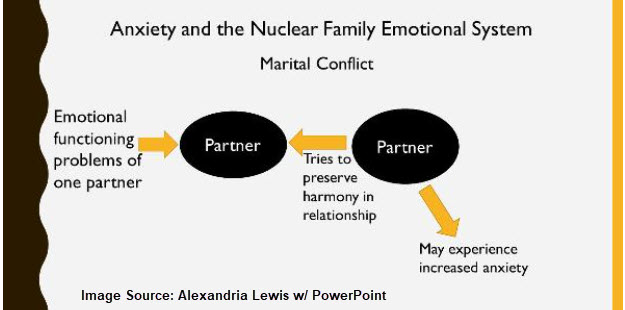
Children are also affected by their parents’ anxiety (Walsh, 2013).
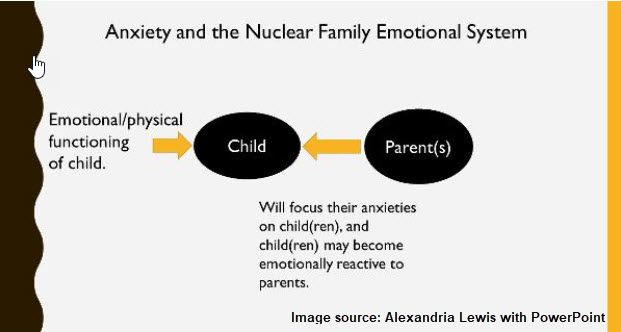
Emotional fusion can result in poor emotionally related boundaries with other family members (Walsh, 2013).
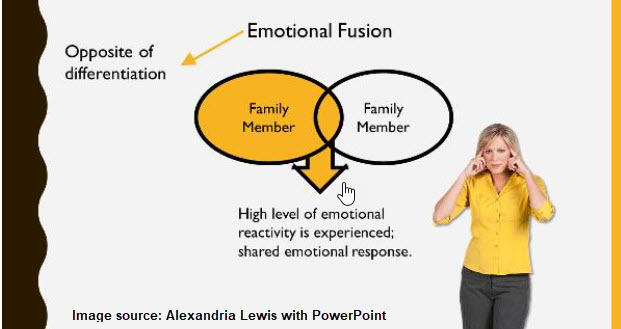
Emotional cut-off can be a healthy/normal part of a family’s experience and can also be unhealthy (Walsh, 2013).
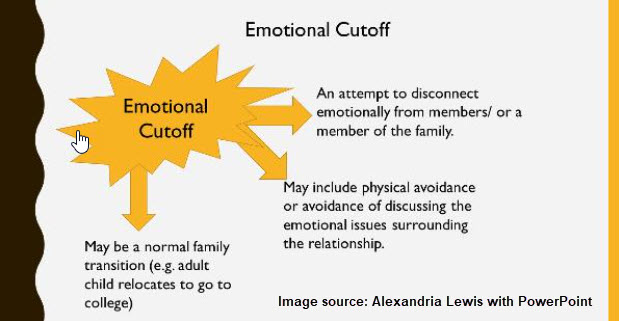
Bowen also believed that birth order/sibling position plays a partial role in the personality of a child (Walsh, 2013).
Techniques
Questioning:
- Uses process questions to explore the dynamics of family relationships; the purpose of these questions is to shift the focus of family members from how others are causing them grief to what they are doing to contribute to family difficulties.
Detriangulation:
- Therapists do not take sides with partners and encourage each person to take responsibility for their part in family dynamics.
Coaching:
- Therapists help families each step of the way so they know exactly what they should be doing.
Therapeutic Triangle:
- Takes place when a therapist joins or engages in work with a couple; the therapist avoids triangulation, assists the couple to address with each other, their challenges.
Genogram:
- A graphic representation of family relationships that include a minimum of three generations.
Family Diagram vs. Genogram
Bowen developed the use of family diagrams, which connected to Bowen family systems theory. Family diagrams were introduced by Dr. Bowen during the 1950’s (Butler, 2008). The terms family diagrams and genograms are sometimes used interchangeably, but there are some differences. Given the timeline of when family diagrams were created, genograms were influenced by family diagrams. Butler (2008) noted, “It is without question that the genogram is derived directly from Bowen’s family diagram” (p. 176). The family diagram was developed based on family systems theory, with an emphasis on the emotional processes of the family unit. In comparison, the genogram is broader in scope.
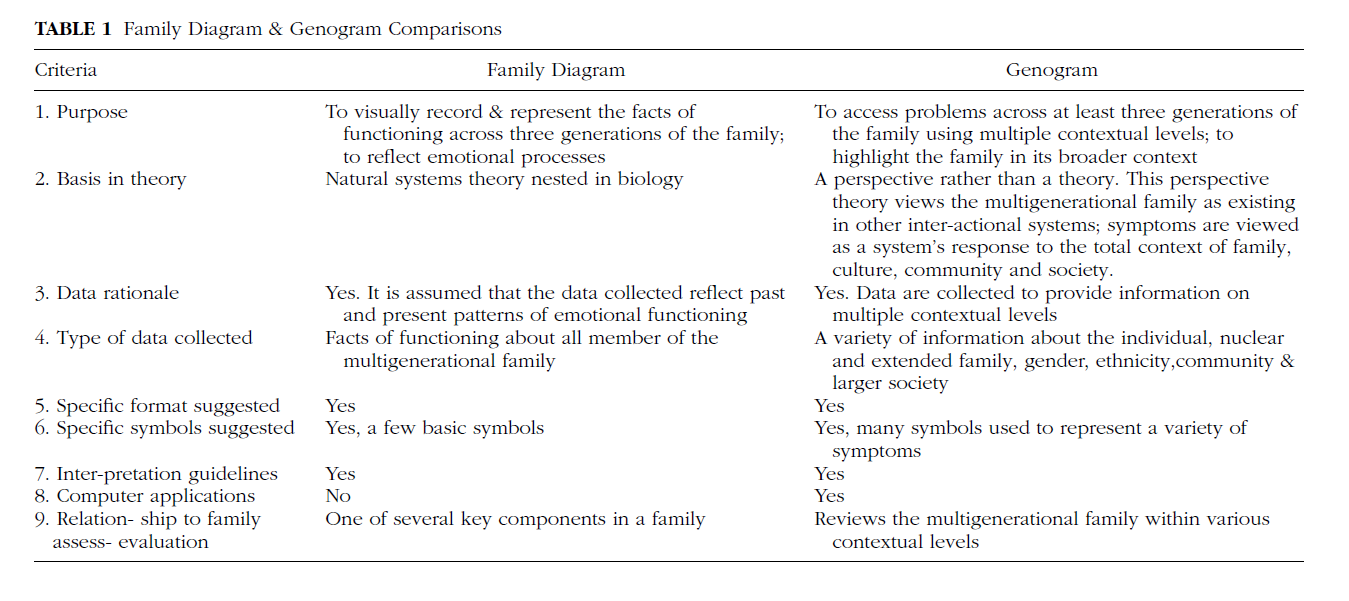
Monica McGoldrick (social worker) and Randy Gerson are recognized as developing genograms. The genogram can be used for both assessment and engagement. Details about relationships, mental health, physical health, resilience/strengths, abuse, etc., help gain essential information about family history and dynamics. Clients are also able to gain insights about their families through the process of completing the genogram. Some agencies use family assessments, including genograms, but genograms are not used in all settings. Genogram symbols are used to represent gender identity, sexual orientation, relationship status, and health status (e.g., substance use, physical health, mental health). Symbols are also used to denote interactional patterns between individuals.
Goals of Intervention
- Improve family system anxiety.
- Enhance awareness of the importance of each family member.
- Foster differentiation.
- Improve each family member’s ability to engage in reflection.
- Build healthy emotions in the family.
- Examine the family problems within a multigenerational context.
Source: Walsh (2013).
Structural Family Theory (Salvadore Minuchin)
This particular theory is focused on the structure of the family; interventions require action from both the social worker and family (Walsh, 2013). In contrast, family emotional systems theory is more reflective. In structural family therapy, clinicians are considered the “expert” and direct the problem resolution process of the family.
Major Concepts
Note: The following activity can be used as flashcards.
Techniques
Note: Click the drop down icon.
Source: Walsh (2013).
Intervention Highlights
As indicated in the name of the theory, there are two focus areas of structural family theory: (1) Executive authority in the family unit (2) Functional family structure (Walsh, 2013).
Intervention Goals
- Realignment of subsystems.
- Short-term resolution of immediate problems.
- Changes in the family structure.
- Enhance boundaries.
- Enhance or maintain the mutual support of family members.
Intervention Strategies
- Enactments during sessions.
- Education about the family structure.
- Emphasize strengths.
- Realign boundaries.
- Manipulation of space.
- Identifying and tracking problematic behaviors.
- When appropriate, join alliances.
Source: Walsh (2013)
strategic family therapy (Jay Hayley)
Major Concepts
- Emphasizes change techniques.
- Belief in rapid change.
- Communication defines relationships
- Therapist plays a directive role.
Techniques
Milan Systematic Family Therapy (Mara Selvini Palazzoli)
Systemic therapy is considered a form of strategic family therapy. It is influenced by the following theoretical perspectives:
- Systems theory
- Cybernetics (studies the processes that control the flow of information in systems)
- Communication theory (the process of information exchange)
Source: Payne, 2014
Techniques
Note: The following is an accordion. Click on the terms to expand the content.
Family Life Cycle
The family life cycle theory is a key concept in fields like marriage and family therapy, family science, and related areas; there are different family life cycle models. These models focus on how families change, adapt, and grow over time by mapping out key transitions a family might experience, especially when it involves children (e.g., formation, maintenance, change, and dissolution of marital and family relations). It is important to note that some of these models are based on traditional/nuclear families.
There is a family life cycle perspective textbook by McGoldrick, Preto, and Carter (2016) that delves into different family life cycle issues including gender, social class, sexuality, spirituality, sibling relationships, single parents, friendships, couples, parents, to name several. Individuals do not develop or live within individual vacuums; however, many theories in psychology solely focus on individual development. As the authors stated, “an individual’s life takes place in the context of the family…..” (McGoldrick et al., 2016, p.1). The authors also mentioned how there has tended to be a focus on individual development from a psychology theory framework (McGoldrick et al., 2016).
McGoldrick et al. (2016) developed a life cycle framework:
- Horizontal factors
- Developmental (life cycle transitions)
- Historical events (e.g., economics, politics)
- Unpredictable (e.g. trauma, accidents, illness, etc.)
- Vertical factors
- Poverty
- Racism
- Disabilities
- Religious beliefs and practices
- Addictions
- Family emotional patterns
- Socio-Cultural Context
- Friends
- Community
- Culture
- Larger Society
- Family
- Family household/structure
- Emotional and relationship patterns
- Values, beliefs
- Rituals
- Individual
- Age, gender, race, ethnicity, etc
- Religious beliefs, spirituality, philosophy
- Relationships with others
- Sense of belonging
- Life skills and self-management
The dimensions of this perspective include: larger society, culture, community, friends, extended family and informal kin, body, mind, and spirit (McGoldrick, et al., 2016).
This model, developed by Betty Carter and Monica McGoldrick, focuses on the emotional and relational development of families. It introduces the concept of the emotional process of transition between stages. Their stages include:
- Leaving Home: Single Young Adults: Emphasizes the separation from the family of origin and development of personal identity.
- The Joining of Families Through Marriage/Union: Focuses on the commitment between partners and the negotiation of family relationships.
- Families with Young Children: Dealing with the changes and challenges of parenting young children.
- Families with Adolescents: Navigating the complexities of raising teenagers and beginning the process of letting go.
- Launching Children and Moving On: Adjusting to life as a couple again or as a single parent, and managing midlife issues.
- Families in Later Life: Covers retirement, coping with the loss of spouses, and life as an older single adult.
Source of the following information about Duvall’s family development theory is shared and adapted under an CC license attribution-non commercial-share alike 4.0 licensed by Diana Long.
According to Duvall’s family development theory (1988), families move through stages in a particular order across time after members successfully master tasks for each stage.
“(a) its family life cycle dimension that provides a basis for study of families over time; (b) its emphasis on the developmental tasks of individual family members and of families at every stage of their development; (c) its built-in recognition of family stress at critical periods in development; and (d) its recognition ever since 1947 of the need for services, supports, and programs for families throughout their family life cycles” – Evelyn Mills Duvall
| STAGE | TASKS |
| Married couple without children | Navigating how to live together. Adjusting relationships with families-of-origin and social networks to include a partner. |
| Childbearing families with the oldest child between birth and 30 months. | Preparing and adjusting the family system to accommodate children. Developing roles as parents. Redefining roles with extended families. |
| Families with preschool children. | Socializing, educating and guiding children. Assessing and adjusting parenting roles as children age and more children join the family. |
| Families with school-age children. | Providing guidance to children while collaborating with outside resources (e.g., school, extracurricular activities). |
| Families with adolescents. | Adjusting parent-child relationships with adolescents to provide more independence with safe limits. Tending to parents’ midlife relationship and career issues. |
| Launching families (first to last child is leaving home). | Navigating adult-to-adult relationships with children. Resolving midlife issues. Caring for aging family members. |
| Middle-age families (“empty/spacious nest” to retirement). | Adjusting to being a couple without children living at home. Caring for aging family members. |
| Aging families (retirement to death of both spouses). | Learning new roles related to retirement, becoming grandparents, losing a partner, and health-related changes. |
Self-Check
Double ABC-X Model of Family Stress
Source of the following information about the double ABC-X model of family stress is shared under an CC license attribution-non commercial-share alike 4.0 licensed by Diana Long.

The double ABC-X model describes the impact of crises on a family. It states that the combination of stressors (A), the family’s resources (B), and the family’s definition of the event (C) will produce the family’s experience of a crisis (X).
The family’s multiple environments influence each component of the model, consistent with the human ecology framework. The double ABC-X suggests that there are multiple paths of recovery following a crisis, and these paths will be determined by the family’s resources and coping processes, both personal and external.
This model is relevant to families that come from another country (e.g., those who self-identify as immigrant or refugee) and live in a new country, as many families experience significant transitions in the process of resettlement. Whether or not this transition, or the events that precipitate it, are interpreted as crises will depend on the family’s other stressors, such as employment, housing, healthcare, and family conflict; family meaning-making,(cultural and family values), and resources (socioeconomic, family support, community).
models of family life education in social work practice
According to the National Council on Family Relations, family life education (FLE)can be defined as: “the professional practice of equipping and empowering family members to develop knowledge and skills that enhance well-being and strengthen interpersonal relationships through an educational, preventive, and strengths-based approach” (para. 1).
Examples of family life education:
- Anger management
- Co-parenting workshops
- Parenting classes
- Family relationship workshops
- Couples enrichment classes
- Financial planning
- Premarriage counseling
- Family financial literacy workshops
Perspectives used in FLE:
- Strengths perspective
- Human development
- System and social role theories
- Person-in-environment
The 10 content areas in Family Life Education (FLE):
- Families and Individuals in Societal Contexts: This area focuses on understanding families and their relationships to other institutions, such as educational, governmental, religious, healthcare, and occupational institutions in society.
- Internal Dynamics of Families: This area focuses on understanding family strengths and weaknesses and how family members relate to each other.
- Human Growth and Development Across the Lifespan: This area focuses on understanding the developmental changes (both typical and atypical) of individuals in families throughout the lifespan.
- Human Sexuality: This area focuses on understanding the physiological, psychological, and social aspects of sexual development throughout the lifespan.
- Interpersonal Relationships: This area focuses on understanding the development and maintenance of interpersonal relationships.
- Family Resource Management: This area focuses on understanding the identification and management of resources from a family systems perspective.
- Parent Education and Guidance: This area focuses on understanding and applying principles of parent-child relationships and guidance.
- Family Law and Public Policy: This area focuses on understanding legal issues, policies, and laws influencing the well-being of families.
- Professional Ethics and Practice: This area focuses on understanding and applying ethical standards and models in professional practice.
- Family Life Education Methodology: This area focuses on understanding and applying principles and techniques of family life education in program planning, implementation, and evaluation.
Each of these content areas includes theory, research, and practice within the field of Family Life Education.
Resource: What is Family Life Education?
References
Butler, J.F. (2008). The family diagram and genogram: Comparisons and contrasts. The American Journal of Family Therapy, 36(3), 169-180. doi: 10.1080/01926180701291055
Lang, D.L. (2020). Parenting and family diversity issues. Iowa State University Digital Press. https://doi.org/10.31274/isudp.8
McGoldrick, M., Preto, N.G., & Carter, B. (2016). The expanding family life cycle: Individual, family, and social perspectives (5th ed.). Pearson Education, Inc.
National Council on Family Relations (n.d.). What is family life education? https://www.ncfr.org/cfle-certification/what-family-life-education
Walsh, J.F. (2013). Theories for direct social work practice. Cengage Learning.

